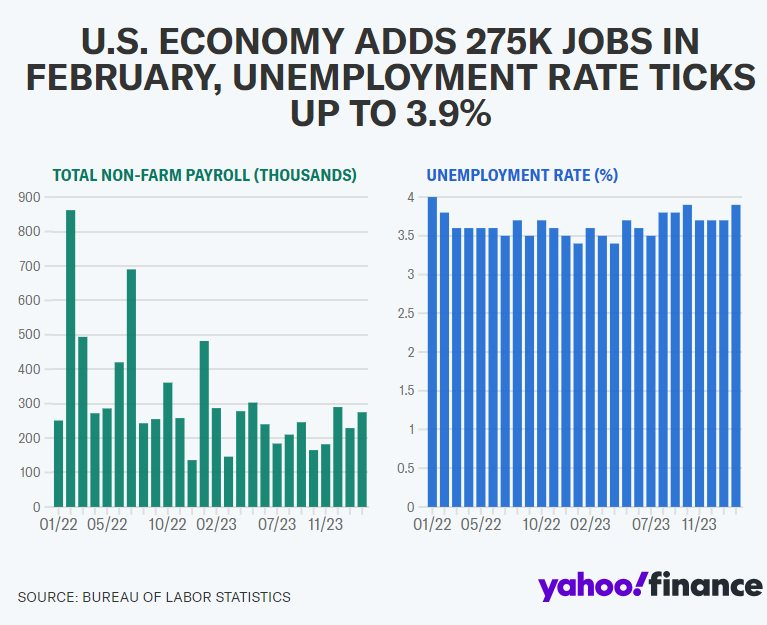FED Rate Cut in June: Will it Depend on This Data?

After two months of robust job growth, the upcoming March employment report is expected to cool down the market. The US Department of Labor’s report, set to be released on Friday, April 5, at 8:30 AM ET, is drawing significant attention on Wall Street.
According to Dow Jones’ consensus estimate, nonfarm payrolls (NFP) for March are expected to increase by approximately 200,000 jobs. While this would mark a cooling from the initially reported 275,000 jobs in February, it still represents a strong overall pace of growth.
It’s worth noting that recent employment reports have seen initial “strong” figures taper off in subsequent revisions, raising questions about whether the labor market is as robust as it seems.

Image Source: Yahoo Finance
In another survey, average hourly wages are predicted to increase by 0.3% compared to February, and by 4.1% compared to the previous year. The unemployment rate is expected to remain at 3.8%, and average weekly hours are projected to hold steady at 34.3 hours, matching the previous month.
The employment report not only serves as a litmus test for the labor market but also provides additional data for the Federal Reserve to consider before making their next interest rate decision.
Federal Reserve Chairman Jerome Powell referred to the labor market as “strong but balancing” in a speech at Stanford University on Thursday.
The strength of the labor market is seen as a key factor in keeping the economy away from a recession while the Fed maintains a tightening stance to combat inflation.
Economist Michael Gapen of Bank of America wrote in a research note, “The March employment report should solidify expectations for a cooling labor market but not a market that is materially weakening.”
Wage data, in particular, will be closely watched in the upcoming report. Following the release of January’s employment data, concerns arose that wages might be rising too quickly, a potential indicator that inflation may not remain subdued in the future. However, the February report largely assuaged those concerns.
Despite the recent uptick in private payroll data, economists expect wage growth to continue slowing in March, with the year-over-year growth rate for average hourly earnings predicted to decrease from 4.3% to 4.1%. On a monthly basis, wages are expected to increase by 0.3% compared to February.
“For the Fed, I think what’s more important is what’s happening with wage growth right now. Whether NFP is at 200,000 or 250,000 or 300,000 doesn’t really matter as long as wage growth isn’t at 0.4-0.5% per month for a couple of months,” said Max Kettner, a multi-asset strategist at HSBC, in an interview with Yahoo Finance Live.
Gapen of BofA added, “If the March employment report shows a lack of overheating (via moderate wage growth), then we expect the Fed’s rate cut in June to hold steady.”
On the other hand, Dan North, Chief Economist at Allianz Trade Americas, expects the Fed to wait until July before starting to cut rates, contrary to current market expectations.
[Reference: CNBC, Yahoo Finance]
Business Today is closely monitoring the upcoming US employment report, as it will play a significant role in the Federal Reserve’s decision-making process. Stay updated with the latest financial and economic news by visiting Business Today.
